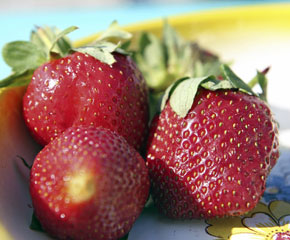An apple a day? A punnet of strawberries is far more likely to keep the
doctor away. That according to British nutritionist Patrick Holford,
author of several books on healthy eating including the New Optimum Nutrition Bible.
“Strawberries are as close as you can get to the perfect fruit,” he
says. “In addition to being an important food if you’re watching your
weight (because they have little sugar, no fat and are low GI) they
provide numerous benefits, from boosting energy levels to slowing the
signs of aging.”
True enough, five strawberries have more
anti-oxidants than 4 bananas. They also help prevent cancer, colds,
hayfever and asthma and are reputed to be an aphrodisiac and to help
with hangovers.
Strawberries are an especially tasty source of vitamin C
(ascorbic acid). In fact, one cup of fresh strawberries provides about
88 mg of ascorbic acid, which more than meets the Recommended Daily
Dietary allowance of 45 milligrams for the average adult. Vitamin C is
well retained when the strawberries are handled carefully, but capping,
injuring, cutting, or juicing, however, will reduce the vitamin
content. They are also one of the few sources, along with grapes and
cherries, of ellagic acid, a compound which has been shown to prevent
carcinogens from turning healthy cells into cancerous ones.
To soothe sunburn, lighten your skin or even treat acne, mash a few
ripe strawberries and spread the pulp over your face. Relax for 10 to
15 minutes and then rinse off with lukewarm water. The astringent
quality of the berries will cleanse your skin and close your pores.
Strawberries or raspberries can also be used to whiten both skin and
teeth, simply rub on and leave for 10 minutes.
The word strawberry comes from the Old English streawberige,
most likely because the plant sends out runners which could be likened
to pieces of straw.
The strawberry is a member of the rose family, and
native to Eurasia and North America (extending over to North Africa and
down to Chile in South America), and locals ate them for eons before
the first colonists shipped strawberry plants back to Europe, as early
as 1600, and where they were later commercially grown.
The modern
Garden Strawberry Fragaria ananassa, which is the main species grown these days, arose in the gardens of Europe as a hybrid between two New World species.
Strawberries have been successfully grown in South Africa for the last
50 years, with Gauteng and the Western Cape producing most, but also in
Kwa-Zulu Natal.
A number of varieties are available (both fresh and
processed) for local consumption and the export market. Among the
varieties are the Spanish Sabrosa, the Italian Naid and Eris, the Uval
and Doron from Israel (mostly exported), the Mara de Bois variety from
France, and the big and juicy Commitment and Endurance from America.
Strawberries are farmed all year round, but September to December is
peak season.
5 things to do with strawberries:
Strawberry liqueur
Lemon yoghurt with strawberries
Strawberry and goats cheese salad with smoked chicken
Scottish salmon
Real strawberry shortcakes

